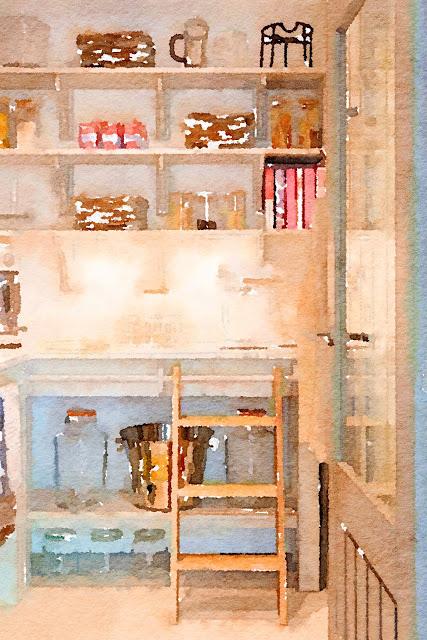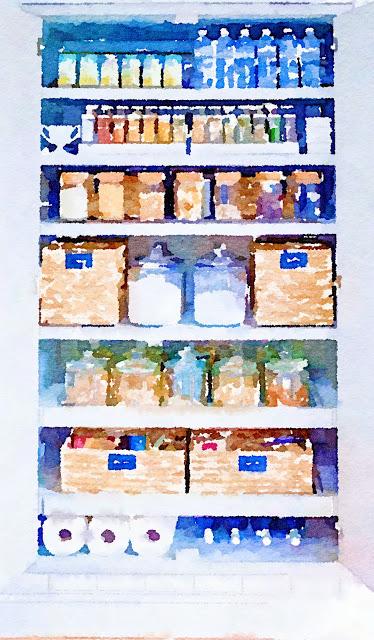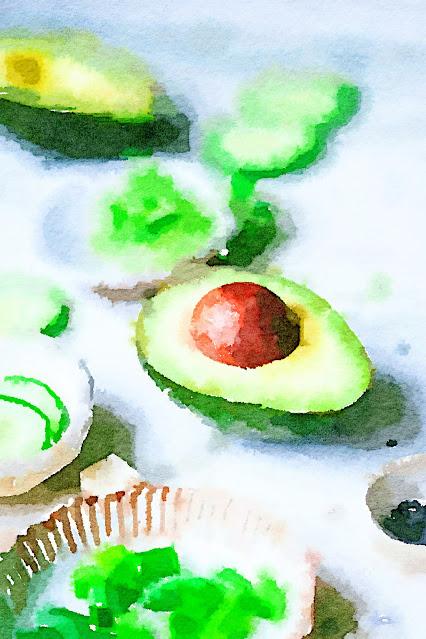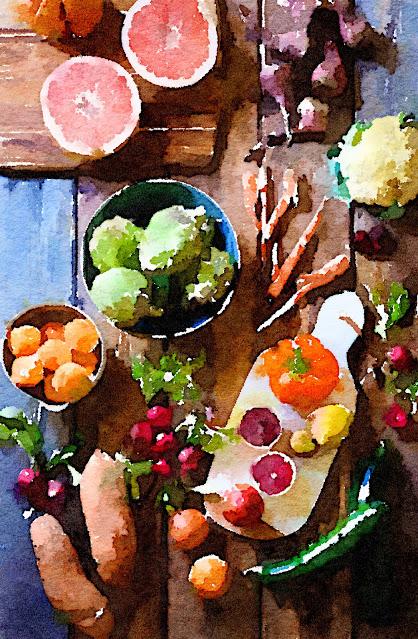
Its been many years since I have had to stock a kitchen again from scratch, and I have never had to do it with just one person in mind, so I thought it would be fun to share my ideas for a well stocked kitchen with you this morning.
If you have a well stocked kitchen and pantry, it is much easier to create meals at the last minute or at least with a minimum of planning involved. Once stocked, your weekly grocery shop will be more about replenishing what you have used, as well as adding special ingredients you might need for the meals you have planned for the coming days.
Every item in your kitchen/pantry should have:
1. A long shelf life.2. Great versatility. You should be able to turn to them for a wide variety of recipes.3. Be "season"-less. You should be able to use these items, regardless of what time of year it is.
This is my plan for having a well stocked kitchen with all the tools and ingredients needed to help make cooking and preparing food for yourself or a family easy and enjoyable.
*Handy Tip - If you keep a pad and pencil in your kitchen, you can jot down a pantry item each time you run out of it. This will make your trips to the grocery store much better planned!

Essential Tools and Equipment
Buy the best that you can afford of these things and they will more than pay for themselves in their longevity.A good set of pots and pans containing at the very least a good sized skillet, several saucepans and a Dutch oven sized pan. You may not always be cooking for just yourself and it only makes sense to have normal sized pots and pans. In addition you may want to stock a few extra smaller ones for when you are all on your own. An 8-inch skillet is the ideal size for just one person.
Roasting tins (One medium and one large)
Casserole dishes (small, medium and large)
Cutting Boards. I like to have several good plastic cutting boards and one good wooden cutting board. I don't like to mix boards, preferring instead to use separate boards for fruits and vegetables and for raw meats and poultry. The wooden board is good to have for cutting loaves and breads. You may also want to have a cutting board that is dedicated to carving cooked meats and poultry. This one should have a narrow recessed area all around the perimeter to catch any juices. All of your boards, with the exception of the bread board, should have rubber edges or feet to help to keep the boards in place when using.
A good set of knives. You will need a good set of knives to help with the preparation of your food. I recommend a good chef's knife, a paring knife, a boning knife, a serrated knife and a good pair of kitchen scissors are musts. You don't need to buy the most expensive knives, but do buy the best that you can afford to buy. A good knife sharpener is also a must. A good can opener.
A good vegetable peeler.
A good box grater with a variety of hole sizes. I also like to have a small holed micro plane grater which is great for grating small amounts of citrus zests and fresh nutmeg, as well as Parmesan cheese.
An assortment of good cooking utensils such as tongs, a slotted spoon, a large spoon, several egg/pancake turners (wide and narrow), a ladle, etc. I like to get silicone coated ones which can help add to the longevity of your pans by preventing unnecessary scratches, etc.
An assortment of measuring cups and spoons. (Both glass and metal)
Several wooden spoons.
A good rolling pin. I have a beechwood pin which I was able to bring over from the UK. A good rolling pill will last many life times.
Several small whisks are very helpful when making single serving salad dressings or just for whisking together a few eggs.
Fine meshed sieves in a few sizes
A medium to large sized colander
A blender (either a stick or a full sized)
Mixing bowls. I like to have these in a variety of sizes, usually three. Small, medium and large. I prefer glass as they are easier to get squeaky clean, which is especially important when you are talking about whisking egg whites, etc.
Baking tins. You will want a variety of good quality baking tins. I have chosen to purchase two round 8-inch baking tins, one round 9-inch tin, one each square 8 and 9-inch tins, one 9 by 13 inch baking tin. A Jelly roll tin (half sheet pan, rimmed), one full sheet pan, rimmed and one quarter sheer pan. Two six cup muffin tins. (That way you are equipped to bake six or 12 muffins depending on your need.) Eventually I will purchase myself a mini muffin tin. Perfect for making small tarts and cakes. Also nice to have is a medium sized non-stick Bundt tin. Also two pie plates (9-inch) and two loaf tins. ( 9X4)
A good digital instant read thermometer. Essential when you may not be used to cooking individual pieces of chicken or fish, or even when you are cooking for larger groups. A good thermometer takes the guess-work out of cooking.
A digital scale. You will find a digital scale invaluable for weighing out proteins, vegetables and pastas to ensure you have the right portions necessary for the recipes you are cooking.
Several kitchen timers. Ideal for reminding you when you have something cooking in the oven. I like to have at least two.
A good heavy electric hand whisk, and or stand mixer.
A pastry blender and a potato masher.
A small microwave oven. Ideal for heating things up and making smaller sauces.
Plastic storage containers in a variety of sizes. Great for storing your opened packages of flour, sugar, salt, etc. You will also want some cheaper ones for use in storing leftover cooked foods.
Food storage bags. I prefer zip lock bags. Great for freezing individual portions of meats and poultry, or keeping fresh cheeses, etc. fresh.
Ice cube trays
Dish towels, dish cloths, dish brushes, pot holders and hot pads.
Nice to have but not necessary
ToasterKettleToaster ovenFood processorStand mixerCitrus juicerSalad spinner

In the Pantry
Spices and Herbs
These things are expensive. If you are able to buy smaller amounts in a bulk bin type of a store, this is best as then you won't have waste. By buying what you need and paying for smaller amounts you won't be left with jars of partially used spices in your cupboard. It also makes sense to do this when you are buying specialty spices that you may only be using irregularly.For cooking
Sea salt (fine and flaked)Black pepper, ground and whole peppercornsParsley flakesDried BasilDried OreganoGround CuminGarlic and Onion PowdersPaprika (smoked and sweet)Chili powderChili flakesany favorites that you know you will use frequentlyFor baking
Ground cinnamonwhole nutmegscloves (ground and whole)dried powdered gingerground cardamom
Dry Goods
All purpose flourBaking powderBaking sodaCocoa powderGranulated sugarLight or dark brown sugarIcing sugarOatmealChocolate (chips and darker chocolate for baking)An assortment of canned beans (only what you think you will use)Dry pasta (at the very least elbow macaroni and spaghetti)Dried beans and lentilsRiceCooking oil (Canola, light olive)Extra virgin olive oil (for salads)Vinegar (a good balsamic, white and red wine, cider)Good canned tunaCoconut milkSeveral tinned soupsGood canned tomatoes (whole and chopped, in juice)Tomato pasteOlives (green and black)Beef, chicken and vegetable broths (canned, tetra bricks or powdered)Smooth peanut butterHoneyMaple Syruponionspotatoes and or sweet potatoesgarlic

The Refrigerator
Only buy fresh produce that you need and think you are going to be able use within the week. Before you go shopping, take stock of what you already have and dispose of anything that is no longer any good.
EggsCheeseButterYeastLardPlain yogurtCream (heavy and sour)Milk (2% and buttermilk)A good mayonnaiseA good Dijon mustard (also a grainy if possible)Pickles (both sweet and sour cornichons)Jams or jellies as desired (I always have strawberry jam and orange marmalade)Lemons, limes, oranges (I always have lemons and buy the others as needed)ApplesFresh lettuceTomatoesCucumberCelery Spring onionsFresh herbs as needed

In the Freezer
I like to buy larger packs and then freeze individual pieces so that I can pull them out and defrost as needed and cook. Only freeze in larger quantities if you know you are going to be cooking for more. It is important to label your freezer bags with the date and contents. I also double bag to insure freshness.
Meats, etc.
Chicken ( breasts and thighs, boneless, skinless) Fish ( I like cod, haddock and salmon)Ground beef (I buy grass fed organic lean)Pork chops (I like bone in)Beef Steak ( both a stewing and a frying)Stew beef or lambMiscellaneous
Bread Crumbs (regular and panko)Nuts (usually walnuts and pecans)Coconut (flaked and desiccated)Frozen fruitFrozen vegetablesA variety of frozen juices (apple and orange)Pastry (all butter puff and regular short crust)a few individual sized ready meals for just in case

Use it up, don't throw it out
It can be really hard to use up ingredients when you are only cooking for yourself. What do you do with the half a can of corn you didn't use or the half can of beans? Here are some ideas and tips for safely storing some of these ingredients.
Canned Items
Beans and vegetables - drain well and pat dry with paper kitchen toweling. Transfer to small freezer containers, or zip lock baggies. (double bag) Lay flat to freeze
Coconut milk - Opened coconut milk will keep for up to a week in the refrigerator, but for longer storage you will want to freeze it. Whisk together until it is well blended and then pour into ice cube trays. Pop into the freezer to freeze. Once frozen, pop out and into freezer containers or zip lock baggies.
Chipotle Chiles in Adobo and Tomato Paste - Line a baking sheet with baking parchment or wax paper. Spoon the chiles and sauce into TBS sized dollops on the baking sheet and then freeze until solid. Pop off and into freezer containers or zip lock baggies. You can do the same with tomato paste. Alternately, if you have purchased it in a can, open the end of the can and push the paste out into a zip lock baggie. Cut off only as much as you need from the frozen log.
Other Items
Avocado - Did you know you can freeze avocado? It freezes perfectly and works well in salads, sandwiches, mashed, or guacamole once thawed. Halves -Just cut them in half lengthwise, place them on a tray, and sprinkle each half with lemon juice. Freeze until solid and then pack into airtight bags or containers.Cubed - Cube and do as above.Mashed - Mash with a bit of lemon juice, pack into a zip lock baggie, removing as much air as possible, freeze flat.Bread - If you are only one person, the smartest thing to do with your bread is to store it in the freezer, rightly wrapped in aluminum foil and sealed in a zip lock baggie. Hearty crusty bread freezes much better than standard sandwich bread. Make sure it is sliced before freezing and then wrap and store in smaller amounts, wrapped as above. Usually 3 to 4 slices per pack.
Berries - When you bring them home, wash your fresh berries in a bowl containing 3 cups of water and 1 cup of distilled white vinegar. Rinse well under cold running water. Line a salad spinner with 3 layers of paper towel and spin them out for about 15 seconds or until completely dry. Store in a loosely covered container, lined with paper towels in the front of your refrigerator.
Bacon - Coil up individually (Helps prevent sticking) and freeze on a plate. Once frozen, transfer to a zip lock baggie.
Cheese - Remove your opened cheeses from the plastic wrap. Wrap in parchment paper and then in aluminum foil, label and then store in the refrigerator. The paper allows the cheese to breathe and the foil protects it from absorbing other flavors from the fridge, and helps to keep it from drying out.If you have feta cheese and it didn't come in a brine, pop it into a small zip-lock bag or container and pour in just enough oil to cover it. You can keep it this way in the refrigerator for up to 4 weeks. Cheese can also be frozen, wrapped tightly in plastic cling film and then placed into a zip lock baggie. It will keep for up to two months. You can defrost it overnight in the refrigerator when you want to use it, or at room temperature for 2 1/2 hours.
Salad Greens - Store intact heads of lettuce or washed and dried leaves wrapped in moist paper towels in partially open zip lock bags in the refrigerator crisper drawer.
Fresh Herbs - Gently rinse and dry your herbs as soon as you bring them home from the store. Pat dry with paper towels or spin in a salad spinner to dry. Wrap in damp paper towel and place in a partially opened zip lock baggie in your refrigerator crisper drawer. It is important to note that you CANNOT do this with fresh basil. Do not rinse it, simply wrap in clean DRY paper towel, place in a partially opened zip lock baggie and store in the crisper drawer.
Onions - To store chopped, sliced or halved onions, store in a zip lock baggie in the refrigerator, rinsing before using. For delicate leeks, chives and spring onions, place the ends in a glass of water, cover loosely with a zip lock baggie and store in the refrigerator.

These things may seem like a no-brainer to some people, but I am sure there are many people out there who don't know where to begin. When you are setting up a kitchen for the first time, it can be overwhelming as to where to start. I really hope that this information, hints and tips will be valuable to each of you. A well stocked/kitted out kitchen allows you to have more options in your cooking journey and to be able to create a simple meal from scratch at the drop of a hat.
If you stock your kitchen with these items you are sure to never feel like "there is nothing to eat" ever again.
This content (written and photography) is the sole property of The English Kitchen. Any reposting or misuse is not permitted. If you are reading this elsewhere, please know that it is stolen content and you may report it to me at mariealicejoan at aol dot com.

